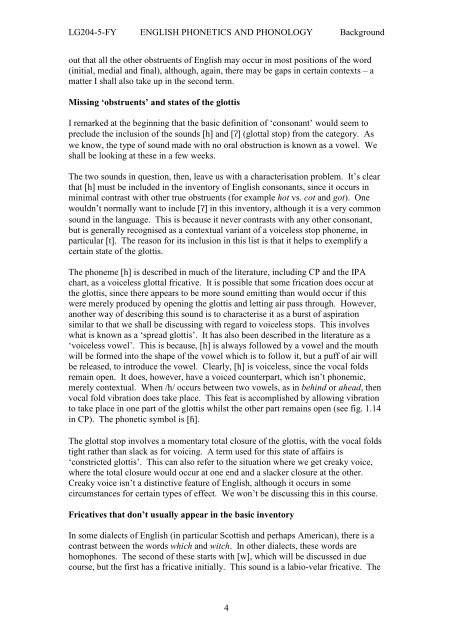LG204 background.pdf
LG204 background.pdf
LG204 background.pdf
Create successful ePaper yourself
Turn your PDF publications into a flip-book with our unique Google optimized e-Paper software.
<strong>LG204</strong>-5-FY ENGLISH PHONETICS AND PHONOLOGY Background<br />
out that all the other obstruents of English may occur in most positions of the word<br />
(initial, medial and final), although, again, there may be gaps in certain contexts – a<br />
matter I shall also take up in the second term.<br />
Missing ‘obstruents’ and states of the glottis<br />
I remarked at the beginning that the basic definition of ‘consonant’ would seem to<br />
preclude the inclusion of the sounds [h] and [] (glottal stop) from the category. As<br />
we know, the type of sound made with no oral obstruction is known as a vowel. We<br />
shall be looking at these in a few weeks.<br />
The two sounds in question, then, leave us with a characterisation problem. It’s clear<br />
that [h] must be included in the inventory of English consonants, since it occurs in<br />
minimal contrast with other true obstruents (for example hot vs. cot and got). One<br />
wouldn’t normally want to include [] in this inventory, although it is a very common<br />
sound in the language. This is because it never contrasts with any other consonant,<br />
but is generally recognised as a contextual variant of a voiceless stop phoneme, in<br />
particular [t]. The reason for its inclusion in this list is that it helps to exemplify a<br />
certain state of the glottis.<br />
The phoneme [h] is described in much of the literature, including CP and the IPA<br />
chart, as a voiceless glottal fricative. It is possible that some frication does occur at<br />
the glottis, since there appears to be more sound emitting than would occur if this<br />
were merely produced by opening the glottis and letting air pass through. However,<br />
another way of describing this sound is to characterise it as a burst of aspiration<br />
similar to that we shall be discussing with regard to voiceless stops. This involves<br />
what is known as a ‘spread glottis’. It has also been described in the literature as a<br />
‘voiceless vowel’. This is because, [h] is always followed by a vowel and the mouth<br />
will be formed into the shape of the vowel which is to follow it, but a puff of air will<br />
be released, to introduce the vowel. Clearly, [h] is voiceless, since the vocal folds<br />
remain open. It does, however, have a voiced counterpart, which isn’t phonemic,<br />
merely contextual. When /h/ occurs between two vowels, as in behind or ahead, then<br />
vocal fold vibration does take place. This feat is accomplished by allowing vibration<br />
to take place in one part of the glottis whilst the other part remains open (see fig. 1.14<br />
in CP). The phonetic symbol is [].<br />
The glottal stop involves a momentary total closure of the glottis, with the vocal folds<br />
tight rather than slack as for voicing. A term used for this state of affairs is<br />
‘constricted glottis’. This can also refer to the situation where we get creaky voice,<br />
where the total closure would occur at one end and a slacker closure at the other.<br />
Creaky voice isn’t a distinctive feature of English, although it occurs in some<br />
circumstances for certain types of effect. We won’t be discussing this in this course.<br />
Fricatives that don’t usually appear in the basic inventory<br />
In some dialects of English (in particular Scottish and perhaps American), there is a<br />
contrast between the words which and witch. In other dialects, these words are<br />
homophones. The second of these starts with [w], which will be discussed in due<br />
course, but the first has a fricative initially. This sound is a labio-velar fricative. The<br />
4
















